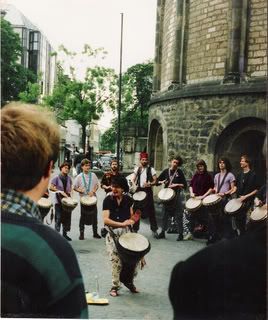
Lilian Friedberg performing with students from her djembe classes in Bonn, Germany, Summer Solstice, 1991
I said in another post that coming to the US in 1993 as a long-time student of Famoudou Konate was like trying to get people excited about Wynton Marsalis in a place where no one knew who he was. For someone who'd been involved in the first wave of djembe drumming to hit the German "scene" in the late 80's--following the death of Sekou Toure, the historical event that made it possible for artists from Guinea to begin their work as independent artists in Europe, a development that ultimately led to their subsequent success on the US American market--coming to the US as a djembe drummer in the early 90s was fraught with difficulties. The situation was complicated by the fact that I was female, and the notion that women were not even allowed to touch the djembe was widespread in the US. Had I been a man, it might have been easier. The fact that I am neither black nor white didn't help much: I was returning to the country to care for my then 104 year old great grandmother--when she died at the age of 107, she may well have been the oldest living Ojibwe in the state of Wisconsin.
After ten years in Europe, I was wholly unprepared to confront the complex maze of identity politics I was about to enter when I landed in O'Hare that day, in the heat of the Rodney King riots. As a mixed blood American Indian, returning to my "Homeland", my "roots," my "Africa," as it were, wasn't going to be as easy as I'd thought.
In Germany, it was self-evident that a woman--regardless of ethnic or racial descent--should be as capable and able to play djembe as anyone else. Silvie Kronewald, Famoudou Konate's "right hand man" in Europe for many years, had set the tone on that score:
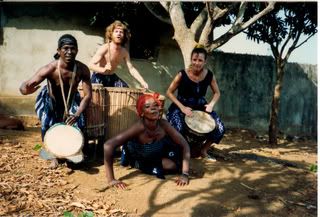
Promotional Photo for Famoudou Konate Ensemble, Famoudou Konate, Paul Engel, Silvie Kronewald and Fanta Kaba
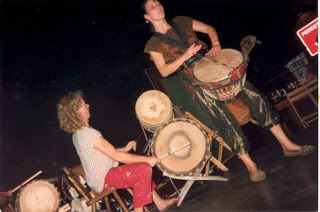
Silvie Kronewald performing with the Famoudou Konate Ensemble, Wuppertal, 1991
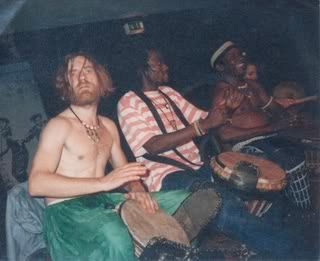
Paul Engel, Alseny Camara, Famoudou Konate, Concert in Wuppertal, 1991
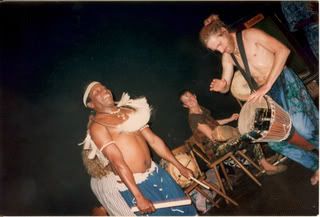
Famoudou Konate, Silvie Kronewald, Paul Engel, Concert in Wuppertal, 1991
At the time, women made up the bulk of participants in Famoudou Konate's workshops--both in Europe and in Guinea. In Europe, I was not an anomaly. In the US, I was viewed as an alien landing from another planet.
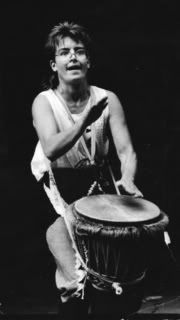
I don't have many images to offer from those early years: no photos from that first European workshop with Famoudou Konate in Toulouse, only a few photos from workshops with Soungalou Coulibally in Freiburg, here is one:

I have very few photos from the myriad Famoudou Konate concerts and workshops I attended from 1987-1993. We were too busy drumming and dancing to take pictures, and this photo from the recording sessions of the now classic Famoudou Konate CD produced by the ethnomusicological of Berlin (Rhythmen der Malinke) in Guinea speaks volumes:

Pictures weren't a priority: practice was!
Here's a shot of Alseny Camara, at the percussion school in Wuppertal where I taught for several years. I'd organized workshops for him there the first year he came to Europe--1991. Note the Famoudou Konate Ensemble poster for concerts I'd organized in Wuppertal hanging on the wall!

And would the pictures have made matters any better? I doubt it. In the minds of most Americans, the "Hitler Channel"-view of Germans as goosestepping Nazis still prevails, even today. Just a few years ago, when I asked students in one of my German literature classes at the university why they'd signed up for my class, one of the kids said: "The only thing I know about Germany is Adolf Hitler, and I'd like to learn something else." And that was from an "educated" American--a third-year student at a public university.
In the mid-90s, I applied to a major grantmaker for a fellowship to study with Famoudou Konate in Berlin: the grant was rejected with the justification that if I wanted to study with Konate, I should do so at his home in Conakry (in August, at the height of the rainy season in Africa when the best drummers are busy teaching and performing in Europe!). Another artist was given a grant to study with some no-name drummer in Seattle. I resisted the temptation to write the grantmaker, asking if there was something I didn't understand about the city of Seattle that made it more suitable to the study of African drumming than Berlin.
The same year, I applied to a state arts agency for a grant to bring Famoudou Konate to the US--the proposal was signed by Famoudou Konate, but rejected by a state arts agency based on the argument that "women are not encouraged to play these drums in Africa" (yes, I have it in writing). Famoduou was shocked. Careful observers will note that in his 1996 book, many of the images of djembe drummers are of women. According to his account, this was partly in response to the stories I told him about my adventures in America when I met with him in Berlin in 1996--on a trip I ended up financing myself.
The aversion to women playing djembe is deeply entrenched, even today. I once witnessed a budding young djembe drummer's spirit crushed when a man snatched the djembe from her hands, telling her "Women aren't supposed to play these drums!" I've purged most of the vile commentary along these lines that's been posted to our Youtube page, in response to my drumming, and to these women as well.
Nowdays, I show my young female djembe students this video before I even start teaching them--just to prepare them for what resistance may come.
In a concert at the UFA Fabrik that year, Famoudou addressed the assembled audience and told the story of how the djembe drum had actually been created--more or less by accident--by women in the kitchen, when a woman broke a hole through a mortar with a pestle:
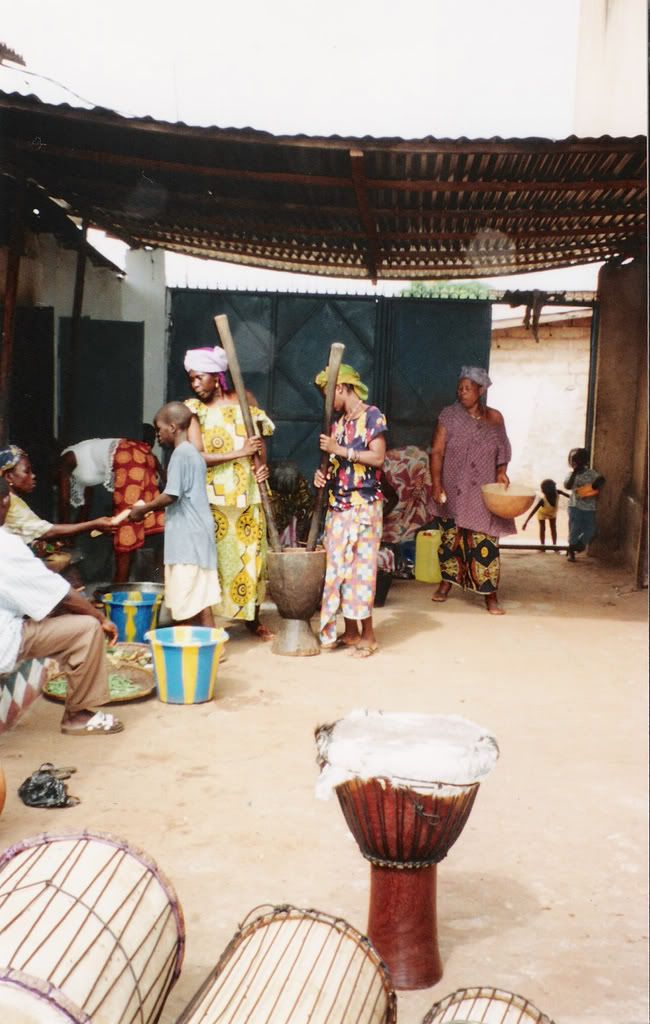
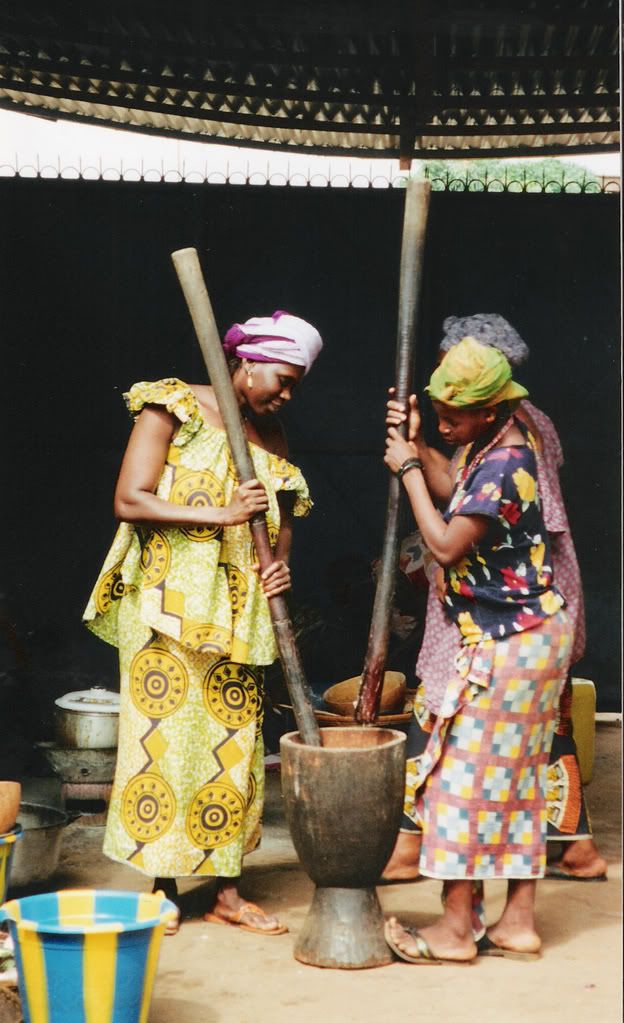
I recently tried to explain this to an American woman I ran into in an African shop. The name Famoudou Konate apparently meant nothing to her--although she'd just explained that her son had recently begun traveling to Guinea. I said, "This is the story that Famoudou Konate told at a concert in Berlin, I have it on videotape..." She stopped me right there and said, "I don't care what they're saying in Germany--I want the story straight from Africa. For all I know, you're just making that up. I'll have to see it in writing before I believe that."
To make a long story short: I'll be posting some more contemporary images of "djembe drumming in Djermany" in the effort to help American viewers understand the extent to which djembe drumming has become a a part of public life in Germany.
Lilian Friedberg and Tina Idiado on Djembe, Bremen, Germany 1988



No comments:
Post a Comment